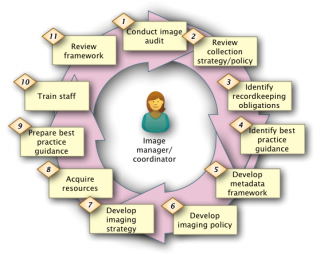Imaging framework table of contents
1 Introduction
1.1 About this document
1.2 Basis of the guidance
1.3 Using this guidance
2 Need for image management
3 Image management process
3.1 Plan image
3.2 Create image
3.3 Post-process image
3.4 Store image
3.5 Use/share image
3.6 Migrate image format
3.7 Archive image
3.8 Add metadata
4 Components of an image management framework
4.1 Collection strategy/policy
4.2 Recordkeeping obligations
4.3 Imaging use
4.4 Metadata requirements
4.5 Imaging policy
4.6 Imaging strategy
4.7 Business cases
4.8 Best practice image management guidance
4.9 Best practice imaging guidance
4.10 Images
5 How to develop and implement an image management framework
5.1 Conduct image audit
5.2 Review collection strategy/policy
5.3 Identify recordkeeping obligations
5.4 Identify best practice guidance
5.5 Develop metadata framework
5.6 Develop imaging policy
5.7 Develop imaging strategy
5.8 Acquire resources
5.9 Prepare best practice guidance
5.10 Train staff
5.11 Review framework
6 A minimal image management framework
6.1 Centralised storage
6.2 Image and imaging governance
7 Resources and timings
8 More information
Imaging Framework v1.0 [.pdf 4.8MB], provides advice on developing and implementing an image management regime. It provides an overview of the:
- need for image management
- image management process
- components of an image management framework
- framework development process—for both a comprehensive and minimal framework
- developmental timings and resources.
While the guidance is intended for use by natural history collections and institutions, we believe it is also relevant to other organisations that create, use or manage extensive collections of images.
The framework is built around an 11-step process:
- Conduct image audit
- Review collection strategy/policy
- Identify record keeping obligations
- Identify best practice guidance
- Develop metadata framework
- Develop imaging policy
- Develop imaging strategy
- Acquire resources
- Prepare best practice guidance
- Train staff
- Review framework
